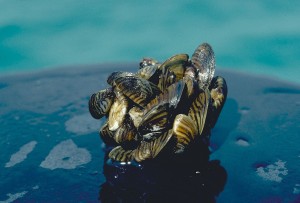A new way to control invasives in the Adirondacks?

Zebra mussel cluster. Photo: D. Jude, Univ. of Michigan, via
NOAA Great Lakes Environmental Research Laboratory, Creative Commons, some rights reserved
This summer, Paul Smith’s College and the East Shore Schroon Lake Association are working on a program aiming to control the spread of aquatic invasive species. Researchers are trying to see how effective it is to flush a boat’s water-holding compartment of remnant water in preventing the spread of zebra-mussel larvae and other microscopic aquatic invasive species.
“Boats that are not properly drained and dried prior to use are a major risk for spreading various [Aquatic Invasives, or AIs] from water body to water body,” State Department of Environmental Conservation Commissioner Joe Martens said in a press release. He said that the pilot program would evaluate the practicality and boater acceptance of flushing these water-holding compartments prior to launching.
New regulations require that boats be drained of water and that the boat, trailer, and associated equipment be cleaned of all visible plant and animal substances before launching from or leaving DEC land where vessels can head into the water. Boat-launch stewards at DEC boat launches on Cranberry Lake, Second Pond, Great Sacandaga Lake and Schroon Lake are asking boaters to flush the bilge, livewells, and baitwells if they contain remnant water from a prior boating trip.
Boats whose hulls are infested with zebra mussels will be directed to a boat-cleaning facility or marine repair shop that offers those services. The stewards will also evaluate various kinds of spray equipment that can be used at boat launches that don’t have electric and water services. They will also assess the receptivity of boaters to the program.
“Our ultimate goal is to develop a simple and effective methodology that boaters can follow that provides the desired protection from the spread of AIS but at the same time does not unduly burden boaters or overly restrict boating,” said Martens. He hopes this will be available at other boat-launch facilities in the future.
Eric Holmlund, director of the Adirondack Watershed Initiative Stewardship Program, said he hopes some version of this new procedure will be both effective and efficient in removing small-bodied organisms, and will be relatively convenient for boating parties. “Most importantly, we hope it spreads the message to boat owners that even small amounts of water carried in livewells, bilge areas and motors present a risk of spreading aquatic invasive species, which can cause costly ecological disruption.”
Flushing out water-holding compartments complements the boat-inspection program now conducted by four “highly motivated” lake stewards of the East Shore Schroon Lake Association, said their spokesperson Rich Nawrot. He said that those stewards are available seven days a week at the Horicon boat launch.
Additionally, zebra-mussel researcher Dr. David Wong of SUNY Oneonta is contributing to the effort by looking into other effective ways a boat owner can remove remnants of water and plant matter, like using car-wash facilities as well as salt and potassium chloride solutions.
Tags: environment, invasive species, martens, paul smiths, schroon lake







